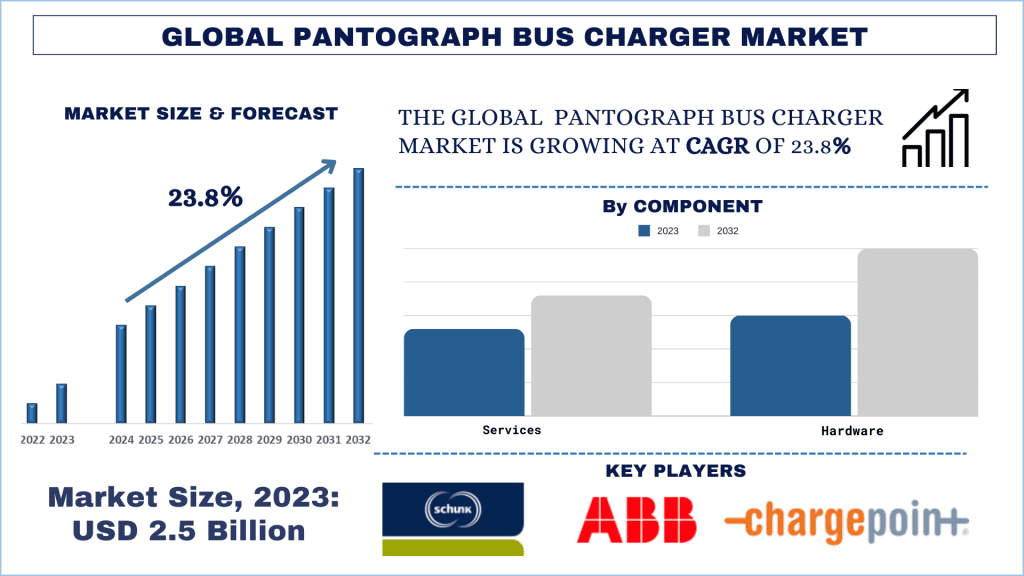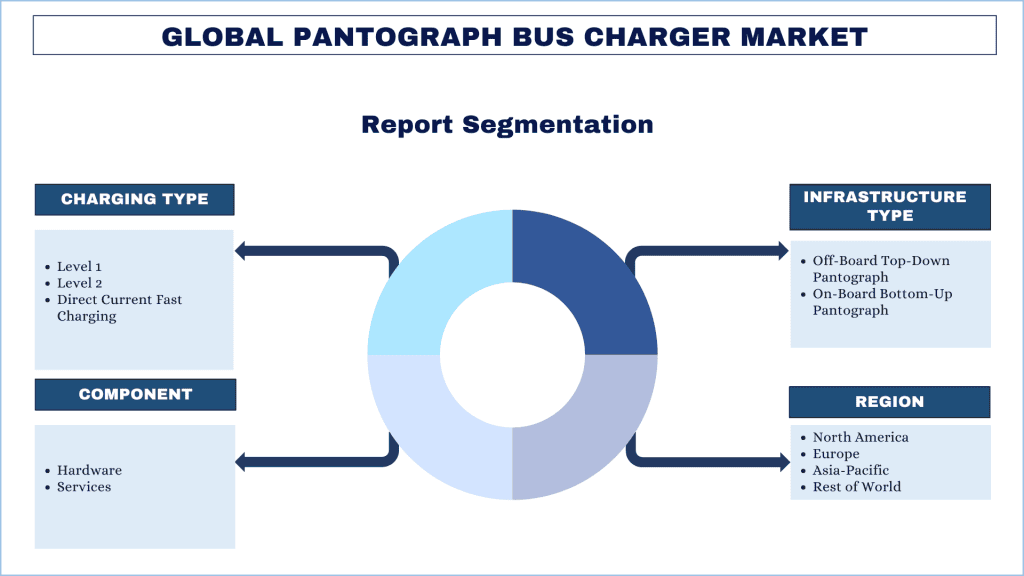- Home
- About Us
- Industry
- Services
- Reading
- Contact Us
Pantograph Bus Charger Market: Current Analysis and Forecast (2024-2032)
Emphasis on Charging Type (Level 1, Level 2, and Direct Current Fast Charging), Component (Hardware and Services), Infrastructure Type (Off-Board Top-Down Pantograph and On-Board Bottom-Up Pantograph), and Region/Country.

Pantograph Bus Charger Market Size & Forecast
The Pantograph Bus Charger Market was valued at USD 2.5 Billion in 2023 and is expected to grow at a robust CAGR of around 23.8 % during the forecast period (2024-2032).
Pantograph Bus Charger Market Analysis
The adoption of electric buses is increasing worldwide, driven by the awareness and environmental impact of traditional diesel-powered vehicles. Governments and municipalities are increasingly adopting the transition to cleaner and more sustainable public transportation, which is fueling the demand for advanced charging technologies. This innovative charging system offers a seamless and efficient solution to the challenges faced by electric bus operators, enabling them to keep their fleets on the move without the need for lengthy plug-in charging sessions. As the global demand for eco-friendly transportation options continues to rise, the pantograph bus charger market is set to experience a remarkable surge in growth.

Pantograph Bus Charger Market Trends
The Global Pantograph Bus Charger Market is witnessing robust growth, driven by the increasing demand for electrification globally. Below, we will discuss a few trends that will boost and drive the market’s growth in the upcoming years.
Growing Adoption of Autonomous Electric Buses
If we consider the ongoing trends of autonomous features in the vehicles launched recently. We can conclude that in the future, autonomous buses will have huge demand in the market; further linked with this market is the pantograph charger market. Charging Infrastructure is one of the most critical pillars in expanding and adopting electric vehicles. Investment and initiatives are being poured into the global pantograph bus charge by the government. Initially, public transportation will be a significant target for the government, as autonomous features and electric buses are being added to public transportation.
Development Of Smart Charging Systems
As development proceeds in electrification, the need for quick and efficient charging systems will increase significantly to curb the insecurities of the market’s consumers. A lot of investment and research is going on in this field to increase the speed and efficiency of charging infrastructure. For instance, On 28 November 2023, Lotus launched its electric vehicle (EV) charging solutions, including an ultra-fast 450 kW DC charger, a power cabinet, and a modular unit for charging up to four cars simultaneously. Charging anxiety remains one of the main barriers to electric vehicle adoption, with nearly 80% of the public citing the lack of charging infrastructure as a primary reason for not buying an EV in a survey conducted by the Energy Policy Institute.

Europe experienced significant growth during the forecast period.
The European electric bus market is undergoing a dynamic transformation with robust growth in the last five years. The increase in e-bus adoption is driven by a factor such as Europe’s climate goals, which include the EU’s aim to achieve net-zero emissions by 2050, which have spurred a widespread shift towards cleaner modes of transportation. Europe’s commitment to sustainable transportation and its leadership in the global clean energy transition. For instance, 2,210 electric buses were sold in 2020, whereas in 2021, 3,282 electric buses were newly registered with manufacturers competing for market shares.
Pantograph Bus Charger Industry Overview
The Pantograph Bus Charger Market is competitive and fragmented, with several global and international market players. The key players are adopting different growth strategies to enhance their market presence, such as partnerships, agreements, collaborations, new product launches, geographical expansions, and mergers and acquisitions. Some of the major players operating in the market are ABB, Wabtec Corporation, Siemens Mobility, Vector Informatik GmbH, Shenzhen SETEC Power Co., Ltd., Schunk Transit Systems, VALMONT INDUSTRIES, INC, Comeca Group, ChargePoint, Inc, and BYD Company Limited.
Pantograph Bus Charger Market News
- In November 2023, ChargePoint announced a pantograph option for the ChargePoint Express Plus charging system, the company’s 500 kW DC charging solution designed to provide a future-proof upgrade to any catenary-fitted depot.
Pantograph Bus Charger Market Report Coverage

Reasons to buy this report:
- The study includes market sizing and forecasting analysis validated by authenticated key industry experts.
- The report briefly reviews overall industry performance at one glance.
- The report covers an in-depth analysis of prominent industry peers with a primary focus on key business financials, product portfolios, expansion strategies, and recent developments.
- Detailed examination of drivers, restraints, key trends, and opportunities prevailing in the industry.
- The study comprehensively covers the market across different segments.
- Deep dive regional level analysis of the industry.
Customization Options:
The Global Pantograph Bus Charger Market can further be customized as per the requirement or any other market segment. Besides this, UMI understands that you may have your own business needs, hence feel free to connect with us to get a report that completely suits your requirements.
Table of Content
Research Methodology for the Pantograph Bus Charger Market Analysis (2024-2032)
Analyzing the historical market, estimating the current market, and forecasting the future market of the global pantograph bus charger market were the three major steps undertaken to create and analyze the adoption of pantograph bus charger in major regions globally. Exhaustive secondary research was conducted to collect the historical market numbers and estimate the current market size. Secondly, to validate these insights, numerous findings and assumptions were taken into consideration. Moreover, exhaustive primary interviews were also conducted, with industry experts across the value chain of the global pantograph bus charger market. Post assumption and validation of market numbers through primary interviews, we employed a top-down/bottom-up approach to forecasting the complete market size. Thereafter, market breakdown and data triangulation methods were adopted to estimate and analyze the market size of segments and sub-segments of the industry. Detailed methodology is explained below:
Analysis of Historical Market Size
Step 1: In-Depth Study of Secondary Sources:
A detailed secondary study was conducted to obtain the historical market size of the pantograph bus charger market through company internal sources such as annual reports and financial statements, performance presentations, press releases, etc., and external sources including journals, news and articles, government publications, competitor publications, sector reports, third-party databases, and other credible publications.
Step 2: Market Segmentation:
After obtaining the historical market size of the pantograph bus charger market, we conducted a detailed secondary analysis to gather historical market insights and share for different segments & sub-segments for major regions. Major segments, such as charging type, component, and infrastructure type, are included in the report. Further country-level analyses were conducted to evaluate the overall adoption of testing models in that region.
Step 3: Factor Analysis:
After acquiring the historical market size of different segments and sub-segments, we conducted a detailed factor analysis to estimate the current market size of the pantograph bus charger market. Further, we conducted factor analysis using dependent and independent variables such as charging type, component, and infrastructure type of the pantograph bus charger market. A thorough analysis was conducted for demand and supply-side scenarios considering top partnerships, mergers and acquisitions, business expansion, and product launches in the global pantograph bus charger market.
Current Market Size Estimate & Forecast
Current Market Sizing: Based on actionable insights from the above 3 steps, we arrived at the current market size, key players in the global pantograph bus charger market, and market shares of the segments. All the required percentage shares split, and market breakdowns were determined using the above-mentioned secondary approach and were verified through primary interviews.
Estimation & Forecasting: For market estimation and forecast, weights were assigned to different factors including drivers & trends, restraints, and opportunities available for the stakeholders. After analyzing these factors, relevant forecasting techniques i.e., the top-down/bottom-up approach were applied to arrive at the market forecast for 2032 for different segments and sub-segments across the major markets globally. The research methodology adopted to estimate the market size encompasses:
- The industry’s market size, in terms of revenue (USD) and the adoption rate of the pantograph bus charger market across the major markets domestically.
- All percentage shares, splits, and breakdowns of market segments and sub-segments
- Key players in the global pantograph bus charger market in terms of products offered. Also, the growth strategies adopted by these players to compete in the fast-growing market.
Market Size and Share Validation
Primary Research: In-depth interviews were conducted with the Key Opinion Leaders (KOLs) including Top Level Executives (CXO/VPs, Sales Head, Marketing Head, Operational Head, Regional Head, Country Head, etc.) across major regions. Primary research findings were then summarized, and statistical analysis was performed to prove the stated hypothesis. Inputs from primary research were consolidated with secondary findings, hence turning information into actionable insights.
Split of Primary Participants in Different Regions

Market Engineering
The data triangulation technique was employed to complete the overall market estimation and to arrive at precise statistical numbers for each segment and sub-segment of the global pantograph bus charger market. The data was split into several segments & sub-segments after studying various parameters and trends in the charging type, component, and infrastructure type of the global pantograph bus charger market.
The main objective of the Global Pantograph Bus Charger Market Study
The current & future market trends of the global pantograph bus charger market were pinpointed in the study. Investors can gain strategic insights to base their discretion for investments on the qualitative and quantitative analysis performed in the study. Current and future market trends determined the market’s overall attractiveness at a regional level, providing a platform for the industrial participant to exploit the untapped market to benefit from a first-mover advantage. Other quantitative goals of the studies include:
- Analyze the current and forecast market size of the pantograph bus charger market in terms of value (USD) and the current and forecast market size of different segments and sub-segments.
- Segments in the study include charging type, component, and infrastructure type.
- Define and analysis of the regulatory framework for the pantograph bus charger
- Analyze the value chain involved with the presence of various intermediaries, along with analyzing customer and competitor behaviors of the industry.
- Analyze the current and forecast market size of the pantograph bus charger market for the major region.
- Major countries of regions studied in the report include Asia Pacific, Europe, North America, and the Rest of the World
- Company profiles of the pantograph bus charger market and the growth strategies adopted by the market players to sustain in the fast-growing market.
- Deep dive regional level analysis of the industry.
Frequently Asked Questions FAQs
Q1: What is the pantograph bus charger market's current market size and growth potential?
Q2: What are the driving factors for the growth of the pantograph bus charger market?
Q3: Which segment has the largest pantograph bus charger market share by component?
Q4: What are the emerging technologies and trends in the pantograph bus charger market?
Q5: Which region will dominate the pantograph bus charger market?
Related Reports
Customers who bought this item also bought










